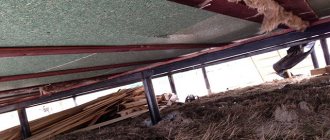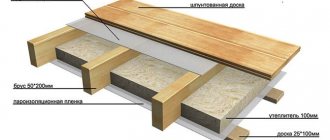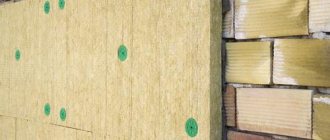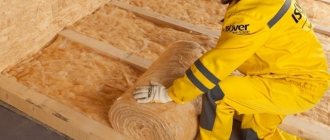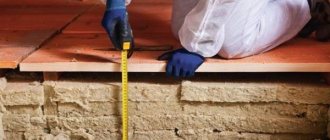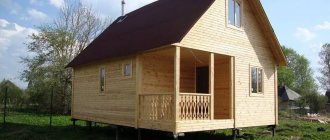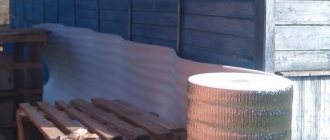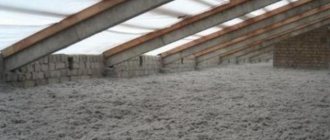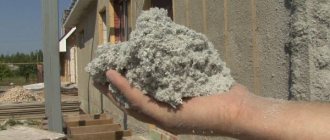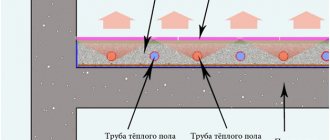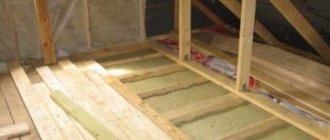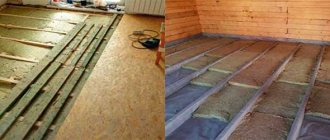Here you will learn:
- General principles of thermal insulation
- In what cases and why is insulation from below correct?
- Features of work on insulating floors with ecowool
- Advantages and disadvantages of ecowool floor insulation
- Calculation of the amount of insulation and the density of its layer
- Ecowool floor insulation technology
Insulating the floor with ecowool in a wooden house can be done manually or mechanically. To insulate with ecowool, you will need to prepare the floors and make cells from boards, and the ecowool needs to be fluffed before backfilling.
What is ecowool?
Before making a choice in favor of ecowool, you should understand what kind of material it is and what it consists of. It is made from waste paper. The consistency is loose, the material is light in weight, and is produced with the addition of substances that prevent combustion and decomposition. Only through their inclusion and impregnation do the fibers acquire durability and avoid rapid destruction. Durability and fire safety are achieved by adding borax and boric acid. Borax affects the fire hazard and increases the safety class to G2, thus the material is used for insulating roof structures, facades, interfloor ceilings and floors of buildings. But its use for insulating air ducts of gas boilers and passages from solid fuel combustion chambers is prohibited. Boric acid prevents the penetration of rodents, rot and fungi. Unlike mineral wool and basalt slabs, in this material there are rarer cases of their penetration and development.
Technical characteristics of ecowool.
The structure of the material is a single mass of long fibers that can ensure the creation of a single and seamless layer of insulation, without the formation of cold bridges. Its application into the interfloor flooring ensures reliable and dense filling of the space and protection of the more vulnerable part of residential premises - the floors.
Thanks to its high technical properties (thermal conductivity reaches 0.040 W/mK) and adjustable density (from 25 to 95 kg/m³), ecowool is not very different from other good thermal insulation materials - mineral or basalt wool, extruded insulation. But there are several parameters that still make it stand out against the general background.
Not like fish in water
The relationship between moisture and insulating materials can be described as complex. Here we need to return to thermal conductivity again. Under normal conditions, as we have seen, this figure is approximately the same for different thermal insulators, but everything changes when moisture gets on the insulation. All materials behave differently. The most moisture-sensitive material is basalt mineral wool; when moistened by 1%, its thermal conductivity increases by 9–8%. Fiberglass also does not tolerate water well, but recently products with enhanced moisture resistance have begun to appear.
Moisture distribution inside ecowool and mineral wool fibers
What's going on with ecowool? It absorbs water, but thanks to the fibrous structure, all the moisture gets into the fibers, and the empty space with air (which is the main heat insulator) remains free, as a result, when humidified to 20%, the thermal conductivity remains unchanged.
Ultimately, the water resistance parameter is relevant only in the event of force majeure (roof leakage, waterproofing breakthrough, etc.). Subject to compliance with building codes and regulations, water should not get on the insulation, so this indicator should not become decisive when choosing a particular insulation material.
Advantages and disadvantages of ecowool floor insulation
The material has numerous advantages, thanks to which it is very popular among users:
- The product is multifunctional. A layer of substance on the ceiling of a multi-story building not only insulates it, but also soundproofs it.
- The fibrous structure adheres well to any surface. It forms an elastic mass that, when installed correctly, does not sag.
- The material is impregnated with antiseptics that are destructive to fungus and mold. Mice do not live in the insulating layer.
- It retains its qualities even at 20 percent humidity, and no vapor barrier is required when laying on the floor.
- Cold bridges never remain in cotton wool. The mixture is supplied in a hose under pressure and fills all voids.
- Working with the substance does not require personal protective equipment.
- Installation of the product is carried out in the shortest possible time.
- Insulation requires a small amount of wool - 28-65 kg/m3.
- After insulation there is no need to wait for the raw materials to dry. Finishing can be done immediately after applying the substance. In addition, it is allowed to work at any temperature and humidity.
- The use of special devices allows you to quickly cover large areas.
Thermal insulation of ceilings with cellulose has a number of disadvantages that the home owner should be aware of:
- Before insulating floors with ecowool, the installation site must be carefully prepared. Preliminary work takes a lot of time.
- The substance is made from waste paper, but the technology is quite complex, so its final cost is much higher than products for a similar purpose. In addition, the insulation process requires special expensive equipment.
- Despite the presence of antipyrine in the substance, under the influence of an open fire, cotton wool begins to smolder. To avoid trouble, it is not recommended to use it in fire hazardous areas. Places near the stove should be protected with asbestos or basalt mats.
- Over time, the cotton wool shrinks, so it is filled with a reserve.
Preparing the base
Insulating the floor in a private country house is not a difficult task at all if you follow some rules. The optimal thickness of the insulating layer should be at least 20 cm. This is enough to minimize heat loss. However, in regions with cold winters, insulation up to 30 cm thick is installed in the floors.
Typically, in private houses, logs are assembled from boards measuring 20x5 cm. The distance between the logs is 60 or 40 cm, depending on the floor covering and expected loads.
OSB sheets or boards treated with an antiseptic are attached to the bottom of the joists to prevent ecowool from shedding. Then, using a stapler, a layer of windproof film is mounted with the rough side up to the heat-protective material. The membrane is laid in rows with a 15 cm overlap.
When insulating an old floor with ecowool, preliminary preparation is also required. Under the structure it is necessary to provide protection against crumbling. To do this, boards or OSB sheets are attached to beams or joists. Insulating material is blown through the holes in the subfloor covering. The size of the holes must be no less than the diameter of the blower hose.
Dry technique
If it is necessary to insulate a frame house, underground space, ceiling, etc., then the heat insulator is applied using a dry method. For this method of laying ecowool, it is necessary either to have a closed cavity or to place the insulated surface horizontally.
Base waterproofing
A typical example of the implementation of the dry method is floor insulation with ecowool.
The work is carried out according to the following scheme:
- Cut-off waterproofing is laid on the base - bitumen mastic, roofing felt, membrane or thick polyethylene.
- A floor frame is mounted on top of the waterproofing - a system of joists supported by adjustable posts or cranial bars.
Blowing material
- Cellulose fiber is blown into the gaps between the joists using a special compressor. In this case, the volume of material is calculated so that the upper boundary of the insulation layer is slightly higher than the upper edge of the joist. This will avoid excessive compaction of ecowool when laying the covering.
It’s not worth saving - slight shrinkage is still typical for the material, so there is a risk that over time large voids will form under the floor.
Covering of boards over a layer of insulation
- A subfloor made of boards or plywood is laid on top of the insulated joists. Laying a vapor barrier membrane is not required.
The method of thermal insulation of walls differs from floor insulation in a slightly greater complexity:
- First, the frame is sheathed, with continuous vertical cavities remaining between the posts, not separated by horizontal partitions.
- To access the insulated cavity, either a special hole is made or a small fragment of the sheathing is not installed.
Blowing through holes in plasterboard sheathing
- As an alternative to sheathing, membranes (Tyvek and analogues) can be mounted on the frame, forming closed cavities and preventing the insulation from crumbling.
- The injection device hose is inserted into the hole in the upper part of the cavity. Ecowool is fed through it, which fills all the free space layer by layer.
Is vapor barrier necessary?
A vapor barrier protects the insulation in a wall or roof from vapors that escape from the house. Warm air, meeting cold air, condenses at the dew point, which usually falls right on the insulation. As we have already figured out, moisture does not have the most favorable effect on thermal insulation material. You can often come across the opinion that when insulating with ecowool, a vapor barrier is not needed. This is not entirely true, because moisture may not damage the insulation itself, but will cause rotting of other structural elements (walls, sheathing, etc.).
- Basalt mineral wool - vapor barrier needed
- Fiberglass-based mineral wool - vapor barrier needed
- Ecowool - it is recommended to use vapor barrier in places with high humidity.
Ecowool floor insulation technology
As a rule, the floor design with some non-fundamental differences looks like this:
- The base of the floor is filled with concrete mortar or remains earthen;
- Next, the subfloor is made up of wooden logs;
- The bottom side is lined with a vapor barrier film (this option is required if the floor is earthen);
- The underside of the subfloor can be additionally covered with a layer of moisture-resistant plasterboard;
- Ecowool is manually poured on top without tamping (see below for the mechanical method of blowing);
- A finishing layer of floorboards, OSB, DSP or laminate is laid on top of the wooden logs and insulation;
- When mechanically blowing ecowool, special technological holes are used in the floor, which has already been laid with the top finishing layer. After the insulation is blown into the cavity between the joists, the technological holes are closed.
This technology allows for seamless insulation of the floor of a country house. Ecowool fills the entire space, covering all communications and electrical cables laid along the base of the floor. After insulation, there are no gaps left between the communication elements and the floor.
Ecowool belongs to the G-2 flammability class and, if wiring in the floor catches fire, it prevents the spread of fire, since it does not burn, but smolders.
Cellulose insulation is not suitable for insects and rodents due to their intolerance to the natural component - borax. This gives the home additional comfort and sanitary safety.
Selection of equipment for installation of ecowool
Before laying, the raw materials must be fluffed to a uniform consistency. Only in this state does it have the necessary insulating characteristics. Mechanization of the process involves the use of special devices that automatically loosen the material and supply it along with air through the pipe to the ceiling.
A typical blow molding device design looks like this:
- Platform on which the engine, gearbox, blower and other components are mounted.
- Electric motor with gearbox - can be two or three stages. This scheme allows the buyer to choose products based on performance and power. Typically, the power plant operates on a low current, which ensures the machine is silent and durable.
- Gateway - designed to capture cotton wool and fluff it up. From it the working mass is fed into the hose.
- Funnel - for loading material into the device.
- Damper - allows you to regulate its flow into the gateway.
- Baking powder - fluffs the compressed substance.
- Remote control - to control the installation. In many products, you can change the speed of movement of biomass and its supply remotely.
- Emergency switch - for quickly stopping the machine.
Advantages of mechanized insulation
Professional equipment is used to insulate the floor with ecowool. The operator smoothly moves the sleeve, ensuring uniform application of ecowool.
Mechanized installation has a number of advantages compared to manual installation:
- Manual labor for carrying material to insulated structures is eliminated;
- The blowing machine fills all hard-to-reach areas and crevices with material;
- A layer of insulation without seams, differences in thickness, with uniform density;
- Thermal insulation does not shrink due to the high density of the layers.
This is interesting: the process of insulating an ecowool area of 100 m², 20 cm thick, manually takes approximately two days. Continuous installation using blow molding equipment lasts 2.5 hours.
To make floor insulation with ecowool as effective as possible, use a professional that not only produces GreenWool insulating material, but also carries out installation using specialized equipment.
The insulation process is not limited to simply applying material to the surface. This also includes a set of related works:
- Assessment of the condition of the object;
- Recommendations to the customer on choosing the method of installing ecowool, the optimal layer thickness, taking into account the specifics of the design;
- Selection of insulating materials to provide protection against moisture penetration into the insulation: steam and waterproofing membranes.
The installation of ecowool on site is carried out by a team of two operators. Our specialists have been trained to work with blow molding machines and have at least 20 years of experience in this field.
Insulation of floors with ecowool is carried out using imported equipment with a productivity of up to 1270 kg per hour, depending on the volume of work. For effective and high-quality thermal insulation, the machines are equipped with additional accessories: hose attachments, adapters, nozzles. This allows you to insulate complex structures and hard-to-reach places.
Professional installation using specialized equipment will guarantee high energy efficiency of a home, industrial facility, administrative building, or other facility.
Conclusion
Based on the results of comparison with other thermal insulation materials, we can highlight the positive and negative aspects of ecowool.
Advantages:
— Seamless application does not form cold bridges.
— Adhesion to the frame provides increased heat and sound insulation.
— Thermal conductivity does not increase when wet
— Good vapor permeability (0.35 mg/(m h Pa)
— Filling hard-to-reach places by blowing cotton wool
— Environmentally friendly - does not contain formaldehyde resins, consists of 80% cellulose
General principles of thermal insulation
The correct technology for thermal insulation of floors consists of five main stages:
- dismantling old floors;
- installation of rough (technical) floor;
- laying insulation and securing it;
- laying a hydro-vapor barrier over the insulation;
- installation and securing of the finished floor.
Each specified stage must be carried out with the utmost care. If errors are made during the installation process, correcting them may require large amounts of time and money. Therefore, it is not recommended to carry out work without prior preparation, in a hurry and without due care.
Calculation of the amount of insulation and the density of its layer
When insulating the floor of interfloor ceilings, it is necessary to remember that the thickness of the layer of material should be 10-20 centimeters, and for the lower and upper floors - 20-30 centimeters. Density with manual open filling is 30-35 kg/m3, with mechanical blowing into a closed cavity - 40-45 kg/m3, and with mechanical open application the density is 35-40 kg/m3.
The mechanical method of blowing ecowool (between the joists) makes it possible to guarantee that the entire internal space of the floor is filled without leaving seams in it. This method allows you to achieve the optimal density of the ecowool layer and give it maximum thermal insulation characteristics.
Necessary equipment for installation of ecowool
The main disadvantage of ecowool is the use of expensive equipment, which not everyone can purchase for domestic use.
In the process of laying the material you will need:
- attachment for a drill or mixer to loosen the material;
- container in which loosening will take place;
- personal protective equipment and gloves to protect hands and respiratory organs from small particles of material.
Having weighed all the advantages (low cost of the material, waste-free and easy installation), we can conclude that ecowool is an excellent way to insulate a residential building.
Features of insulation by logs
How to properly insulate a rough foundation along the joists? During the installation of the thermal insulator, the following scheme must be observed:
- The rough base is lined with boards that must be attached to the joists;
- To prevent moisture from getting under the coating, lay a layer of vapor barrier;
- Then the base is insulated with polystyrene foam, mineral wool or other materials.
If you need to make high-quality thermal insulation of a room above a non-residential and unheated room, then it is better to use mineral wool with a thickness of more than 40 mm as insulation. In this case, the “pie” made from a vapor barrier and mineral wool will retain heat in the room, preventing heat exchange between the cold basement and the first floor.
Ecowool and other heat insulators
When choosing what is best to use for insulating a house, it is important to evaluate the features of the most popular thermal insulation materials. And here we will have to make a decision about what will be used - ecowool or basalt insulation, fiberglass or polystyrene foam.
Comparative energy efficiency is very high
Unlike polystyrene (pictured), ecowool is not damaged by rodents
To compare materials, you can use the table:
| Parameter | Glass wool | Plates based on basalt wool | Expanded polystyrene | Ecowool |
| Thermal conductivity, W/(m*0С) | 0,043 | 0,047 | 0,05 | 0,04 |
| Density, kg/m3 | 15 | 37 | 25 | 35 |
| Vapor permeability | High | High | Low | High |
| Biological resistance | Does not rot, is not damaged by rodents | Does not rot, may be slightly damaged by rodents | Does not rot, severely damaged by rodents | Does not rot, is not damaged by rodents |
| Fire safety | The fiber itself does not burn, but the binder may melt, releasing toxic smoke. | Does not burn; when heated strongly, it can release decomposition products of the binder | Actively melts with the release of large amounts of toxic smoke | Does not ignite, dies out quickly, and when exposed to an open flame it smolders, emitting relatively harmless smoke. |
The special structure of the fibers ensures the preservation of heat-saving qualities when moistened
As you can see, it is not possible to make a clear choice as to which is preferable – ecowool or mineral wool. The material we are considering may well compete with insulation based on mineral fiber, surpassing them in some parameters, and inferior in others.
Heat resistance comparison
From this comparison we can draw a fairly simple conclusion: the decision to use ecowool or other material is best made after a comprehensive analysis of the conditions. This insulation is quite effective, so the main factors of choice will be its availability in the region and the cost of thermal insulation work.
Table of contents
What are we comparing?
Designed to keep you warm. Seamless installation. Not like fish in water Density and weight Does not burn or does not support combustion? Do you need a vapor barrier? Silence in the home Conclusion Ecowool is a modern thermal insulation material with a low shrinkage rate, good resistance to water, and has high sound insulation properties. A similar characteristic can be found about almost any thermal insulation product, but it is only possible to evaluate how effective the material really is by comparison. In this article we will try to compare ecowool with the most common insulation materials.
Ecowool
Technology for laying ecowool in floor construction
- Ecowool is laid in the floor structure between the joists. There is no need to use rubber protective gloves for work; cotton gloves are sufficient.
- Ecowool is poured between the joists onto a pre-laid roll vapor barrier or hemming sheet material.
- The poured ecowool is slammed down with a stiff brush or compacted in any other available way. The volume of ecowool should be 10% greater than the filled volume.
- After drying, the ecowool is covered with glassine and further planning of the floor is carried out.
